For as long as humans have contemplated the Universe, we’ve marveled at the vastness of it all. Was our Universe infinite? Was it eternal? Or did it spring into existence a finite amount of time ago? Over the 20th and 21st centuries, these existential questions for all-time have, one-by-one, fallen into the realm of science, and now have the best answers we’ve ever been able to assemble. As of today, in 2024, we can confidently state that we actually know how old the Universe is: 13.8 billion years old, marking time at the start of the hot Big Bang. If we could step back through time, we’d find that the universe as we know it was a very different place early on. Modern stars and galaxies arose from a series of gravitational mergers of smaller-mass objects, which themselves consisted of younger, more pristine stars. At the earliest times, there were no stars or galaxies, and even farther, no neutral atoms or stable atomic nuclei, going all the way back to the hot Big Bang. Today, astronomers and astrophysicists who study the early universe confidently state its age with an uncertainty of no more than ~1%: a remarkable achievement.
And yet, there’s another part to the cosmic story: the science of astronomy, and specifically the astronomical study of stars. If you can understand how stars work, then simply by observing the physical properties of the stars we see, we can determine their ages and know when they must have been born. Although stars undergo a wide variety of changes as they age, including the evolution of their:
- radius,
- luminosity,
- and temperature,
there are only two main properties that determine the total lifespan of a star: its mass and metallicity, where the latter tells you how much of the star is made of elements heavier than hydrogen and helium.
The oldest stars that we’ve found to date are nearly pristine, made up of nearly 100% hydrogen and helium, where their ages can exceed 13 billion years. Oddly enough, the star which presently has the oldest age determination, the so-called Methuselah star, has an estimated age of 14.5 billion. How can a star be older than the age of the Universe itself? It can’t be. Here’s what must be what’s going on.
Measuring back in time and distance (to the left of “today”) can inform how the Universe will evolve and accelerate/decelerate far into the future. By linking the expansion rate to the matter-and-energy contents of the Universe and measuring the expansion rate, we can come up with an estimate for the amount of time that’s passed since the start of the hot Big Bang. The supernova data in the late 1990s was the first set of data to indicate that we lived in a dark energy-rich Universe, rather than a matter-and-radiation dominated one.
A cosmic age
The cosmic method we have for determining the age of the Universe is actually the most powerful of all methods, as it applies equally well to all observers within the Universe as we know it. This method traces its origins all the way back to the 1920s, when the first evidence for the expansion of the Universe was revealed. In physics, whenever you can uncover the equations that govern your system — i.e., the equations that tell you how your system evolves over time — then all you need to know is what that system is doing at any particular moment in time, and you can evolve it as far into either the past or future as you like. So long as both the laws of physics and the contents of your system don’t change, you’ll arrive at the right answer.
In astrophysics and cosmology, the rules that govern the expanding Universe come from considering a model that is, on average, filled with equal amounts of “stuff” everywhere and in all directions. We call this a Universe that’s both homogeneous, meaning the same everywhere, and isotropic, which means the same in all directions. The equations you get out are known as the Friedmann equations (after Alexander Friedmann, who first derived them), and have been around for a full 102 years now: since 1922.
These equations tell you that a Universe filled with “stuff” cannot remain static and unchanging, but must either expand or contract. Furthermore, the way the expansion (or contraction) rate changes with time is only dependent on two things:
- how fast that rate is at any one point, such as today,
- and what, exactly, your Universe is filled with at that particular moment in time.
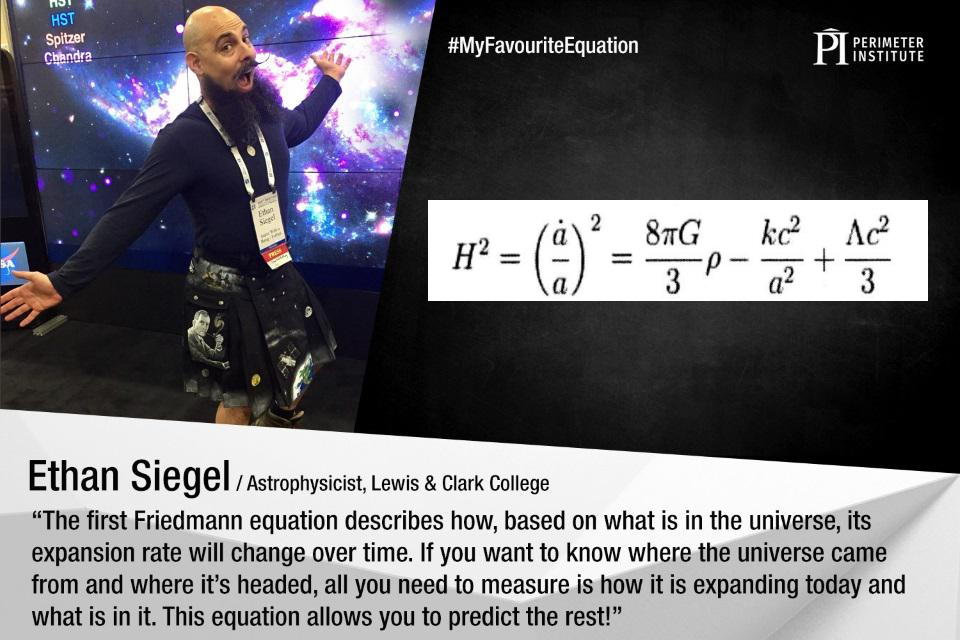
A photo of Ethan Siegel at the American Astronomical Society’s hyperwall in 2017, along with the first Friedmann equation at right. The first Friedmann equation details the Hubble expansion rate squared on the left hand side, which governs the evolution of spacetime. The right side includes all the different forms of matter and energy, along with spatial curvature (in the final term), which determines how the Universe evolves in the future. This has been called the most important equation in all of cosmology and was derived by Friedmann in essentially its modern form back in 1922.
Way back in the early days of cosmology as a science, people used to joke that “Cosmology is the search for two numbers,” where those two numbers were the present-day expansion rate as well as a measure of how the expansion rate is changing with time. This was based on the fact that, if the Friedmann equations describe our Universe, by simply making measurements of:
- what the expansion rate is today (what we know as the Hubble parameter),
- as well as how the expansion rate changes with time (what we historically called the deceleration parameter, which we now realize is a horrible misnomer because that parameter is actually negative; the Universe is accelerating and not decelerating),
then we’d be able to determine precisely what the contents of the Universe are: not just now, but at any point in cosmic history.
In other words, we could know how much of the Universe was in the form of normal matter, how much was present in the form of dark matter, how much was radiation, how much was neutrinos, how much was dark energy, etc. This is a very nice and straightforward approach, because making these measurements simply reflect, directly, the two sides of the Friedmann equation: the expansion of the universe and how it changes with time are on one side, while the matter-and-energy density of everything in the Universe is on the other side.
In principle, measuring one side of the equation will tell you what must be present on the other side. You can then take what you know and extrapolate it back in time, to when the universe was in the very hot, dense, and small-volume state that corresponds to the earliest moments of the hot Big Bang. The amount of time that it takes you to wind the clock back — from now until then — tells you the age of the Universe.

Joint constraints from the Pantheon+ analysis, along with baryon acoustic oscillation (BAO) and cosmic microwave background (Planck) data, on the fraction of the Universe existing in the form of matter and in the form of dark energy, or Lambda. Our Universe is 33.8% total matter and 66.2% dark energy, to the best of our knowledge, with just a 1.8% uncertainty. All of the cosmologies consistent with the data give an age of the Universe between 13.6 and 14.0 billion years.
In practice, though, we don’t simply take the evidence we have that directly points to an answer and declare the problem to be solved. If we were to do that, we would fall prey to any and all errors, both statistical and systematic, that can bias the results from any one class of measurements. To improve our answer, we use multiple lines of evidence to all complement one another. By bringing the full suite of high-quality, reliable lines of evidence together, we can attempt to put together a consistent picture of the Universe that incorporates all that we know. Some of these lines-of-evidence are particularly revealing.
- The large-scale structure of the universe tells us the total amount of matter that’s present (about 30% of the critical density), as well as the normal matter-to-dark matter ratio (about 1-to-5).
- The fluctuations in the cosmic microwave background relate how quickly the Universe is expanding to a variety of components in the Universe, including the total energy density, which must add up to ~100% of the critical density.
- Direct measurements of individual objects, like type Ia supernovae, at a wide variety of distances and redshifts can teach us what the expansion rate today is, and can help measure how the expansion rate has changed over time.
What we wind up with is a picture where the universe appears to be expanding at a rate of around ~70 km/s/Mpc today, made of 68% dark energy, 27% dark matter, 4.9% normal matter, about 0.1% neutrinos, and less than 0.01% of everything else, such as radiation, black holes, spatial curvature, and any exotic form of energy not included in the accounting shown here.
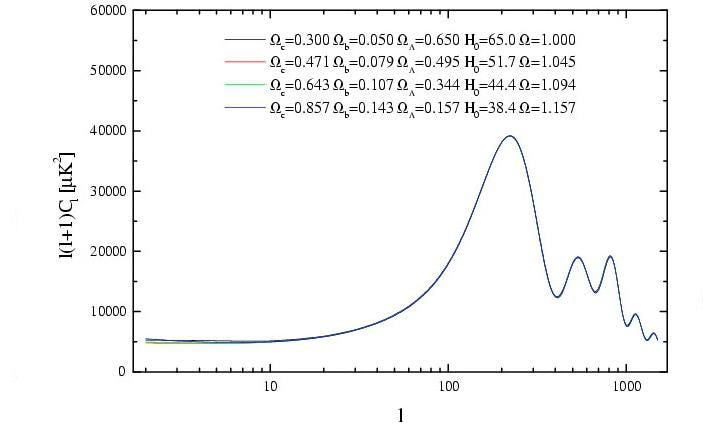
Four different cosmologies lead to the same fluctuation patterns in the CMB, but an independent cross-check can accurately measure one of these parameters independently, breaking the degeneracy. In all of these cases, in order to fit the data we have, the normal matter-to-dark matter ratio must be the same 1-to-5 ratio we observe it to be in the late-time Universe, but the present expansion rate of the Universe is severely different between all four models.
When we assemble these various pieces together, including the rate of expansion today and the known components of the Universe, we get an unambiguous answer for the age of the universe: 13.8 billion years. (This estimate is from Planck data with a modern expansion rate of ~67 km/s/Mpc, superseding the previous WMAP parameters, which gave a slightly higher rate of expansion, a Universe with slightly more dark energy, along with slightly less dark matter, which is how they obtained their earlier, somewhat less-precise value of 13.7 billion years for the Universe’s age.)
It might surprise you to learn, however, that these parameters are all interrelated. If you’ve heard about the Hubble tension, for example, you know that different teams using different methods are obtaining different values for the rate of expansion today. If the expansion rate is more like ~73 km/s/Mpc, as favored by groups who use late-time, distance ladder measurements (like supernovae) as opposed to the ~67 km/s/Mpc obtained by early-time, relic signal methods (like the cosmic microwave background and/or baryon acoustic oscillations), that means that the Universe is expanding by about 9% faster than the preferred value would indicate.
But that still wouldn’t change the age of the universe by up to 9%; in order to fit the other constraints, you’d have to alter the contents of your Universe accordingly. A more rapidly expanding Universe, today, requires more dark energy and less overall matter, which would only decrease the age of the Universe by ~1%, not ~9%. While many different sets of parameters can fit the data from, say, the Cosmic Microwave Background, most models require unrealistic values of parameters such as an expansion rate that’s too low or a large amount of spatial curvature, both of which conflict with observations.
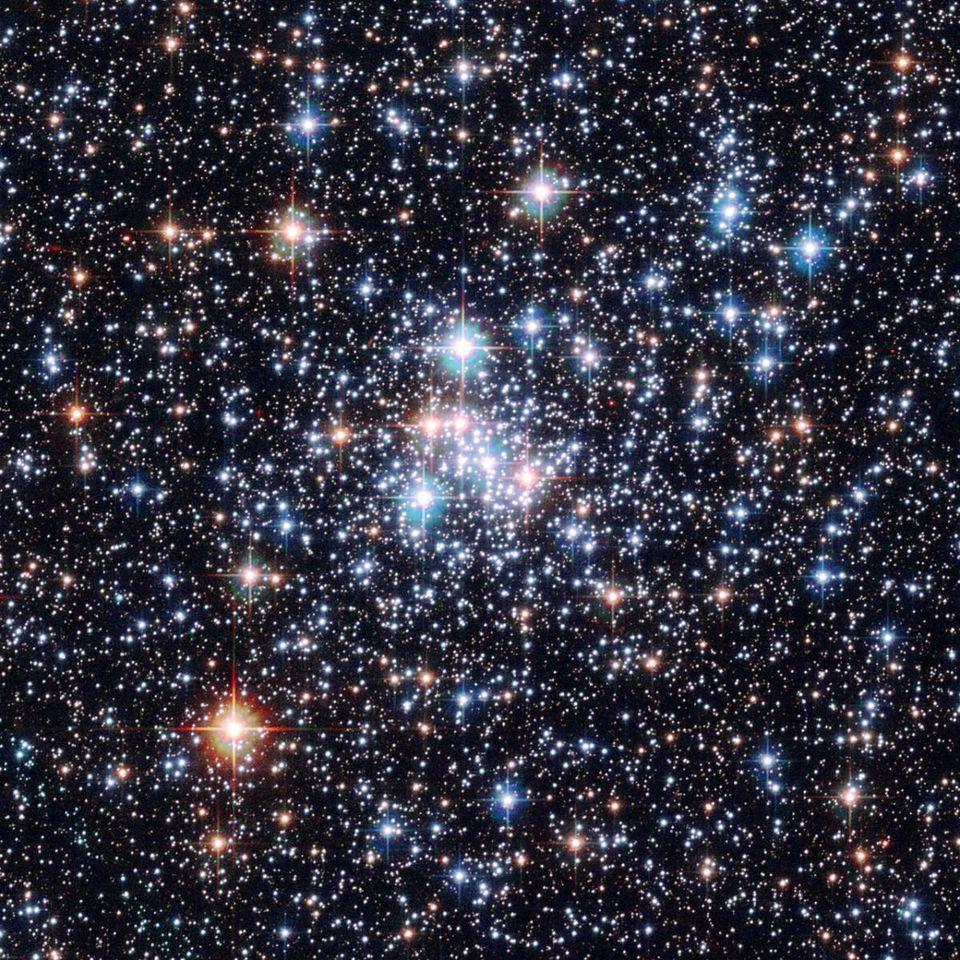
The open star cluster NGC 290, imaged by Hubble. These stars, imaged here, can only have the properties, elements, and planets (and potentially chances-for-life) that they do because of all the stars that died before their creation. This is a relatively young open cluster, as evidenced by the high-mass, bright blue stars that dominate its appearance. Open star clusters, however, never live nearly as long as the age of the Universe.
The ages of stars
Here’s a statement that you’ll probably agree with: “If the Universe itself is 13.8 billion years old, then we had better not find any stars within it that are older than 13.8 billion years.”
The problem with this statement is that it’s very, very difficult to pin down the age of any one star in the Universe, no matter how well we measure it. Sure, we know all sorts of things about stars:
- what their properties are when their cores first ignite nuclear fusion,
- how their life cycles depend on the ratio of elements they were born with,
- how long their total lifetimes are, and how those lifetimes depend on their initial mass,
- and how stars evolve as they burn through their nuclear fuel in various stages.
If we can measure a star precisely enough — which we can do for most stars within a few thousands light-years in the Milky Way — then we can trace back the star’s life cycle to the moment it was born.
That’s true, at least on average. But these statements are true if, and only if, that star hasn’t undergone a major interaction or merger with another massive object over its lifetime. Stars and stellar corpses can do some pretty mean things to one another. They can strip material away, making a star look more-or-less evolved than it actually is. Multiple stars can merge together, making the new star appear younger than it actually is. And stellar interactions, including interactions with the interstellar medium, can change the ratio of elements we observe within them from what was present throughout most of their lives. In other words, the “snapshot” we have of a star may not be representative of the history of that star over the course of its multi-billion year lifespan.

The globular cluster Messier 69 is highly unusual for being both incredibly old, with indications that it formed at just 5% the Universe’s present age (around 13 billion years ago), but also having a very high metal content, at 22% the metallicity of our Sun. The brighter stars are in the red giant phase, just now running out of their core fuel, while a few blue stars are the result of mergers: blue stragglers.
In order to make more accurate measurements, rather than looking at old individual stars, we need to look at the oldest collections of stars we can find: those happen to be the stars found in globular clusters.
Globular clusters exist in and around every large galaxy; some contain hundreds (like our Milky Way), others, like M87 in the Virgo cluster, can contain more than 10,000. Each globular cluster is a collection of many stars, ranging from a few tens of thousands up to many millions, and each star within it will have a color and a luminosity: both easily measurable properties for stars within our own galaxy and for many stars beyond it. When we plot the color and magnitude of each star within a globular cluster together, we get a particularly shaped curve that snakes from the lower-right (red color and low luminosity) to the upper-left (blue color and high luminosity) on what’s called the Hertzsprung-Russell, or color-magnitude, diagram.
Why are curves on a color-magnitude diagram so valuable? Because as the stars within the cluster age, the more massive, bluer, luminous stars evolve off of this curve and toward the upper-right. As stars burn through their core’s nuclear fuel, the core contracts, heats up, and causes the star to swell, becoming first a subgiant and then a red giant star. The more amount of time that passes since the cluster of stars was born, the more “empty” the blue, high-luminosity part of this curve becomes.
When we look at the globular clusters we see, we find they have a wide variety of ages, but only up to a maximum value: 12-something to 13-something billion years. Many globular clusters fall into this age range, but here’s the important part: none are older.
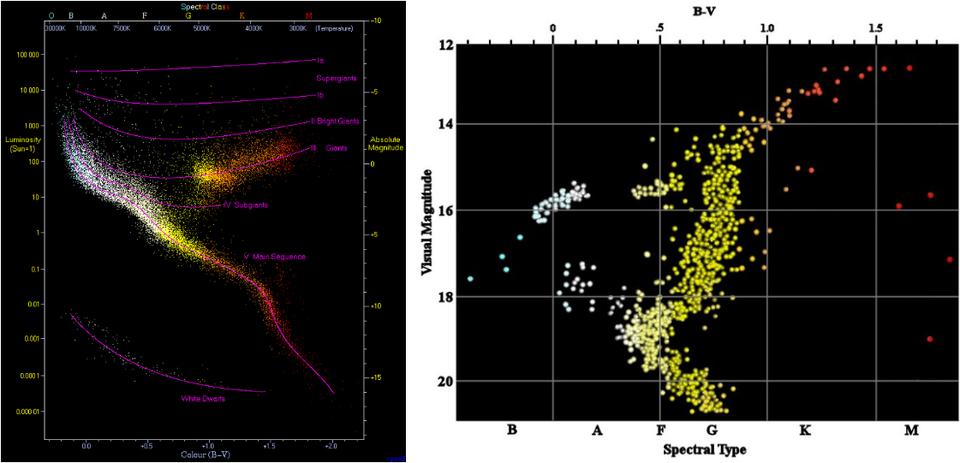
The life cycles of stars can be understood in the context of the color/magnitude diagram shown here. As the population of stars age, they ‘turn off’ the diagram, allowing us to date the age of the cluster in question. The oldest globular star clusters, such as the very old cluster shown at right, have an age of over 13 billion years, but many globulars also exhibit a second, more youthful population of stars alongside the older one: evidence that they had more than one burst of star-formation within them.
Individual stars
When we were talking about the entire Universe, we needed to recognize that our approach was only valid under certain conditions. We had to assume that there were no major, abrupt changes or transitions that occurred in the Universe’s past: where the various species of energy didn’t spontaneously change at a particular instant in cosmic history. Similarly, for stars, we have to keep in mind that we’re only getting a snapshot of how that star is behaving over the timescale we’ve been observing it: years, decades, or centuries at most. But stars typically live for billions of years, meaning that we’re only viewing them for a cosmic blink-of-an-eye, and that many individual stars may have had violent and/or pollutive events occur to them long before any human ever glimpsed them.
In 2007, we were able to measure the star HE 1523–0901, which is about 80% of the Sun’s mass and contains only 0.1% of the Sun’s iron, and determined its age to be 13.2 billion years old from its radioactive element abundances. In 2015, a set of nine stars near the Milky Way’s center were dated to have formed 13.5 billion years ago: just 300,000,000 years after the Big Bang, and before the initial formation of the Milky Way galaxy itself. “These stars formed before the Milky Way, and the galaxy formed around them,” said Louise Howes, co-discoverer of these ancient relics. In fact, one of those nine stars has less than 0.001% of the Sun’s iron; this is exactly the type of star and the classes of stellar population that JWST is hoping to find many more of.
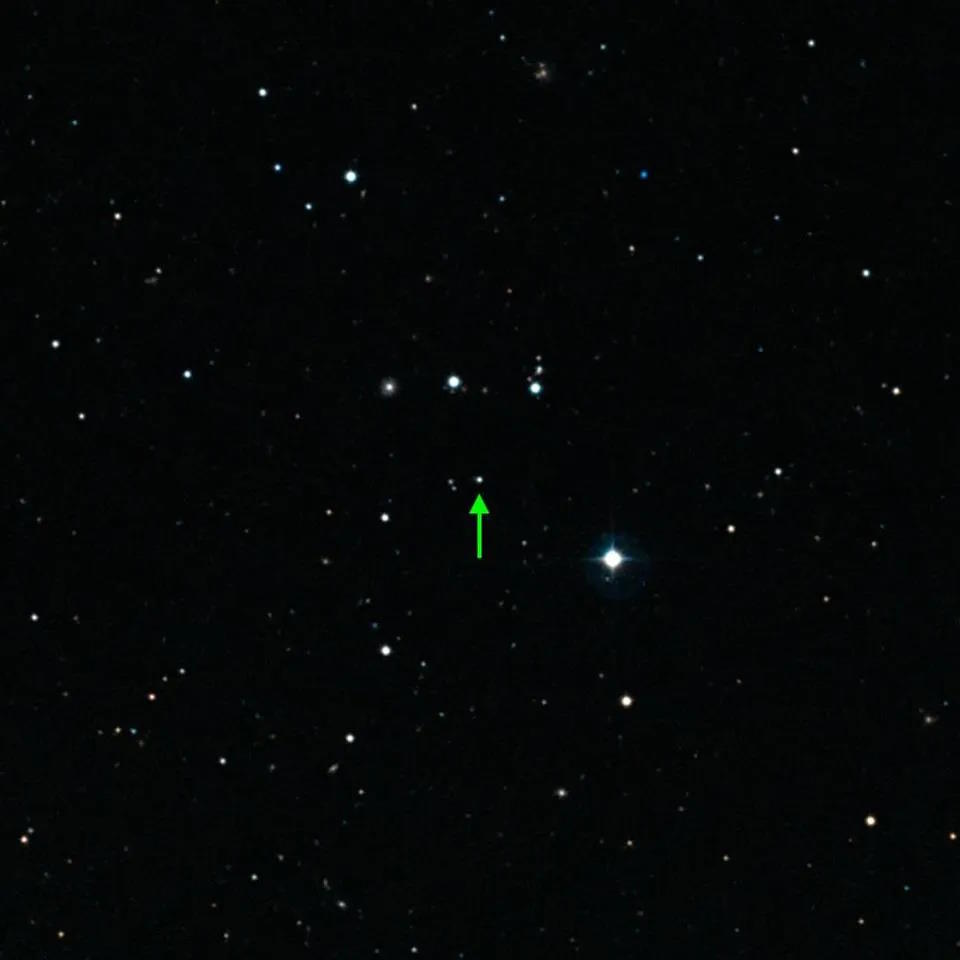
Located around 4,140 light-years away in the galactic halo, SDSS J102915+172927 is an ancient star that contains just 1/20,000th the heavy elements the Sun possesses, and should be over 13 billion years old: one of the oldest in the Universe, similar to but even more metal-poor than HE 1523–0901.
The Methuselah star itself
But the most confusing star of all is HD 140283, informally nicknamed the Methuselah star. At just 190 light years away, we can measure many of its observed properties very well, including its:
- luminosity,
- surface temperature,
- and composition.
We can also see that it’s no longer a main sequence star (on the snake-like curve from the color-magnitude diagram), but rather is just beginning to evolve into the subgiant phase on its inevitable journey toward becoming a red giant. These pieces of information, combined, allow us to get a well-constrained value for the star’s age, and the result is disturbing, to say the least: 14.46 billion years. Yet some of the other properties it displays, like an iron content of 0.4% the Sun’s, suggest that it’s very old, but not quite pristine. What we don’t often discuss, however, when it comes to the age of this star is a critical piece of information: there is a large uncertainty on its age of around 800 million years, and that’s just at the one-sigma (i.e., 68% confidence) level.
Travel the Universe with astrophysicist Ethan Siegel. Subscribers will get the newsletter every Saturday. All aboard!
This value still places the age of the Methuselah star as uncomfortably early, and hints at a potential conflict between how old the stars are and how old the Universe is. However, there’s nearly a 20% chance that the star’s true age is younger than the age of the Universe, and that would imply that there’s no discrepancy at all. Making a determination of a value is one thing; reducing your uncertainties sufficiently so that you’re confident that the value you’ve arrived at is definitively accurate is quite another.
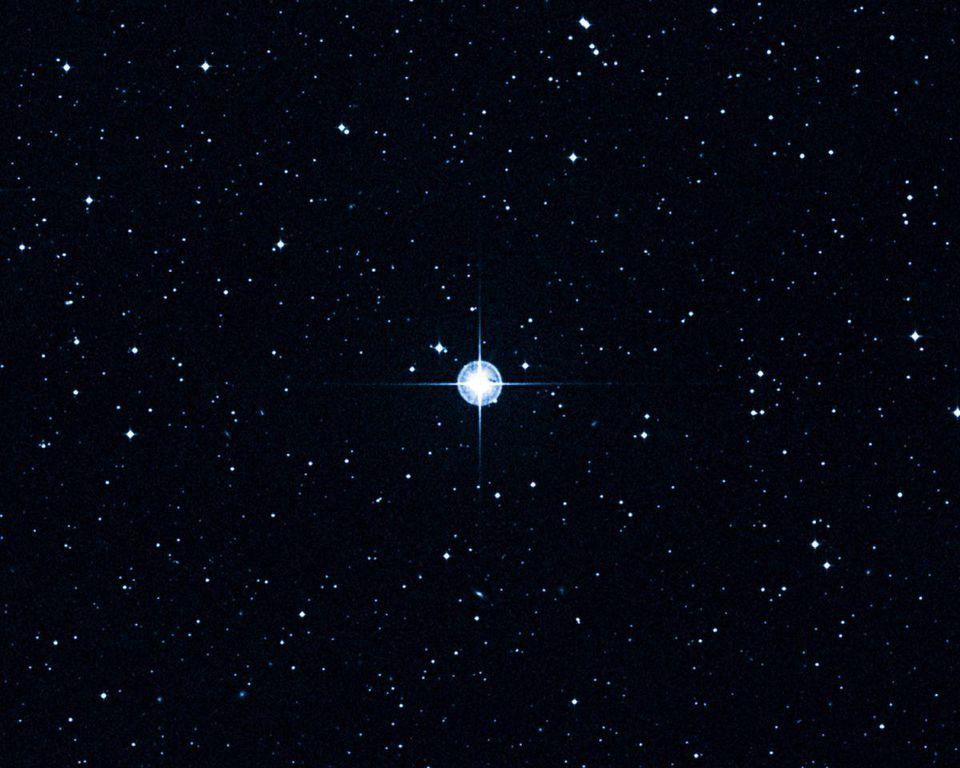
This is a Digitized Sky Survey image of the oldest star with a well-determined age in our galaxy. The aging star, cataloged as HD 140283, lies over 190 light-years away. The NASA/ESA Hubble Space Telescope was used to narrow the measurement uncertainty on the star’s distance, and this helped to refine the calculation of a more precise age of 14.5 billion years (with a substantial uncertainty of plus or minus 800 million years). This can be reconciled with a Universe that’s 13.8 billion years old (within the uncertainties), but not with a significantly younger one.
The overall lesson is this: we should never put too much stock in the age measurement of a single star. We have to be aware that any such measurement comes along with a large uncertainty, and those uncertainties are exacerbated by our ignorance about the history of these stellar systems. The so-called Methuselah star, for example, may be highly unusual in a lot of ways, as it must be in order for us to arrive at an estimated age of approximately 14.5 billion years old: some 700 million years older than the age of the Universe. But that estimate comes along with a large uncertainty of nearly 1 billion years, meaning that the simplest reconciliation of these facts is to consider the possibility that the Methuselah star is an old star, but appears older than it actually is due to historical events whose evidence no longer remains.
From both individual stars and stellar populations to the overall properties of our expanding universe, we can derive a very consistent age estimate for our universe: 13.8 billion years. If we tried to make the universe even a few hundred million years older or younger, we’d run into insurmountable conflicts with the data. A younger universe can’t explain the oldest globular clusters; an older universe can’t explain why there aren’t globular clusters that are even older. Meanwhile, a significantly younger or older universe can’t accommodate the fluctuations we see in the cosmic microwave background. Put simply, there’s too little wiggle-room for us to be wrong about the age of the Universe.
But it’s very easy for us to be wrong about the age of a single star. It’s enormously important, as a scientist, to try to poke holes in any and every aspect of our current understanding. This both helps us ensure our present framework for making sense of the universe is robust, and also helps us explore alternatives and their limitations. We can try to construct a substantially older or younger Universe, but both our cosmic signals and our measurements of stellar populations indicate that a small amount of wiggle room — perhaps at the ~1% level — is all we can accommodate. For individual stars, however, the errors in their age estimates are often tremendous. The Methuselah star, in all probability, doesn’t pose a paradox or a puzzle for the age of the Universe, but rather shows the limitations of drawing cosmic conclusions from just one type of observation. This one star, despite how good we are at astronomy, simply comes along with too many uncertainties.

Dr. Thomas Hughes is a UK-based scientist and science communicator who makes complex topics accessible to readers. His articles explore breakthroughs in various scientific disciplines, from space exploration to cutting-edge research.








